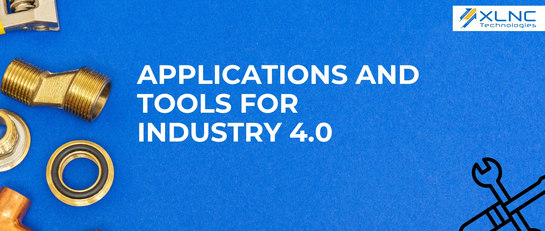Posted on on April 22, 2025 | by XLNC Team

Manufacturing was all about brute force—pushing materials through, churning products, and repeating. But Industry 4.0? It’s playing an entirely different game. We’re talking about factories that learn, predict, and evolve without waiting for human input.
Cyber-physical systems scan every nook and cranny of production, Big Data crunches numbers for smarter decisions, and Edge Computing ensures there’s no lag in execution. The result? Faster, leaner, and ridiculously efficient manufacturing. If projections are right, by 2025, most manufacturers will be running on this next-gen tech.
But what exactly are these technologies doing? And how are they revolutionising the way businesses produce, adapt, and innovate? Let’s take a deep dive.
Industry 4.0 brings advanced technologies to manufacturing, helping businesses work more efficiently and produce better products. Here’s how it works in different areas:
Your factory just got a brain upgrade. Sensors constantly track every vibration, temperature spike, and tiny glitch, fixing problems before they become breakdowns. No more sudden shutdowns, no more losing money on emergency repairs—just smooth, unstoppable production.
Tracking inventory manually? That’s ancient history. AI keeps tabs on everything—what’s in stock, what’s running low, and where every shipment is in real-time. That means zero bottlenecks, no over-ordering, and no scrambling for missing parts. Just smooth, predictable logistics that make you look like a genius.
Robots and AI don’t just replace humans—they enhance production. They build faster, mess up less, and switch between tasks without needing a coffee break. Plus, smart automation allows factories to shift between product lines without missing a beat. More output, better quality, and zero downtime.
To encapsulate, industry 4.0 applications help businesses improve their operations, save costs, and make better products.
IoT devices, digital twins, and cloud computing are notable tools and technologies contributing to the Industry 4.0 revolution. Here's a simple look at each one:
IoT devices are tiny but mighty. These smart sensors track temperature, speed, and pressure—basically, every machine’s vital signs. They alert operators before equipment fails, cutting downtime and saving millions.
Prevents breakdowns before they happen
Optimizes efficiency by spotting hidden issues
Ever wish you could hit undo on expensive manufacturing mistakes? Digital twins make that a reality. These virtual clones of physical machines let engineers test changes before applying them in real life.
Simulate changes before making real-world adjustments
Improve designs and machine performance without costly risks
Cloud computing involves storing and processing large amounts of data online instead of in local computers. This technology supports data from IoT devices and digital twins, making analyzing and sharing information easier.
Access critical data from anywhere, anytime.
Supercharges automation and decision-making with limitless computing power
These tools are key to industrial automation 4.0, creating smarter, more efficient manufacturing processes and helping businesses make better decisions.
As learned, Industry 4.0 is the fourth industrial revolution, which combines new technologies to make manufacturing smarter and more efficient. It includes key components like Cyber-Physical Systems (CPS), Big Data and Analytics, and Edge Computing. Let’s take a closer look at each one.
CPS acts as the nervous system of smart factories—machines, sensors, and software talk, think, and adjust without waiting for human input. This tech makes production smoother, faster, and smarter.
M2M Chatter – Machines handle business independently, reducing delays and human slip-ups.
Future-Proof Fixes – Real-time data spots potential breakdowns before they happen. Say goodbye to surprise shutdowns.
Turbocharged Productivity – No more waiting around—automated systems keep things moving at full speed.
With CPS, factories don’t just work—they react and evolve instantly.
Today's factories don’t run on guesswork; they run on cold, hard data. Every machine, sensor, and system pumps out information that can transform production from clunky to cutting-edge.
No More Flawed Goods – Analytics catches defects before they hit the shelves.
Smarter Supply Chains – Track demand, optimize inventory, and avoid costly overstocking.
Energy Savings = Cost Savings – Identify waste and cut expenses without cutting corners.
Data-driven manufacturing means fewer mistakes, faster decision-making, and a competitive edge.
Cloud computing is great until slow connections or laggy data transfers grind production to a halt. Enter Edge Computing, where decisions happen on the spot, in real-time.
Speed Over Everything – Instant responses mean no delays in automated processes.
Stronger Security – Keeping data local minimises the risk of breaches.
Reliability Boost – Even if the internet fails, operations don’t.
With edge computing, factories stay sharp, secure, and always on. There is no downtime or lag—just seamless efficiency.
Conclusion: Manufacturing has entered its golden era. Machines learn, predict, and react in real time, making old-school trial-and-error methods look prehistoric. AI fine-tunes production, sensors flag problems before they spiral, and cloud computing keeps everything running efficiently.
Industry 4.0 isn’t some distant dream; it’s today's reality. And those who adapt? They’ll dominate. Need a guide in this high-tech revolution? Partner with XLNC Technologies. We have the blueprint and resources to turn your factory into your biggest competitive edge.
1. How does Industry 4.0 improve product quality?
Industry 4.0 uses smart tools and real-time data to catch problems early, making production more accurate and ensuring better product quality with fewer mistakes.
2. What challenges do manufacturers face when implementing Industry 4.0 technologies?
Manufacturers face high costs, the need for skilled workers, and security risks. They also try to make old systems work with new technology.
3. Are robots taking over jobs?
Yes and no. Repetitive, manual jobs? Probably toast. But in their place, AI, robotics, and data analytics jobs are booming. Think less wrench-turning and more algorithm-tweaking.
4. What is the role of Artificial Intelligence (AI) in Industry 4.0?
AI is the mastermind behind Industry 4.0. It predicts machine failures before they happen, optimises production without human intervention and turns raw data into gold. In short, it’s the difference between guesswork and genius.
Comments